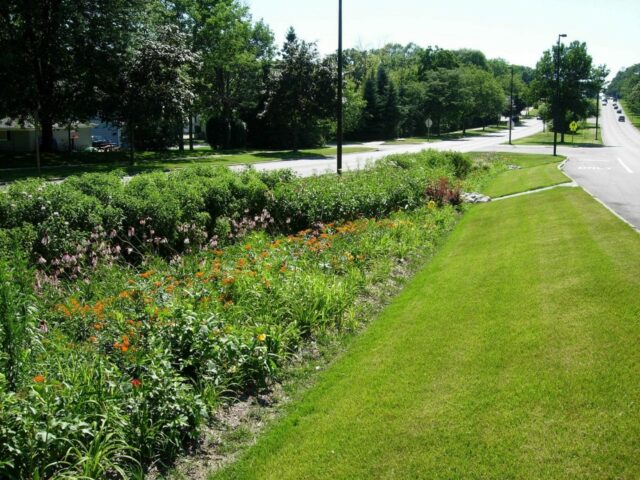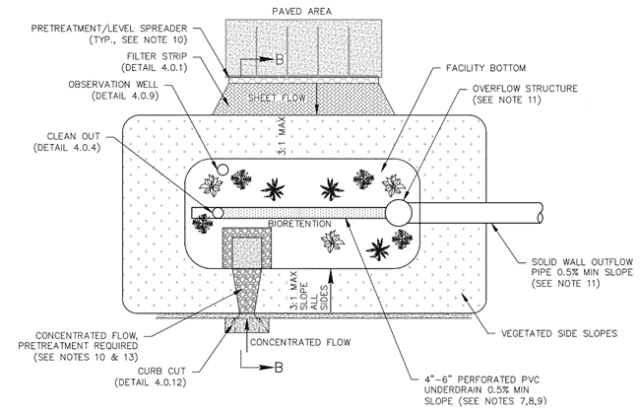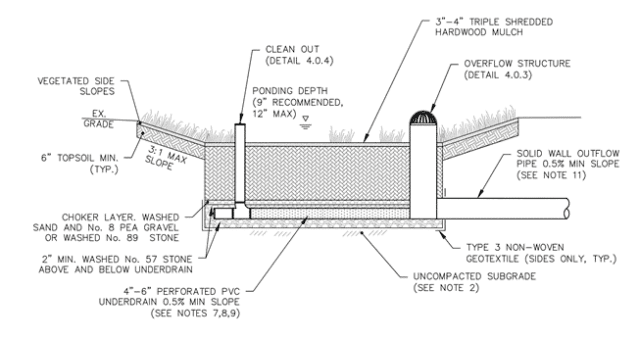Show Notes
The next time you ride through a parking lot, take a moment and look around. There is more going on there than meets the eye. The landscaped island you see may be more than just a cluster of vegetation. It could very well be a bioretention facility.
While the name sounds like an elaborate name for a jail, the term has a positive denotation. A bioretention facility, sometimes referred to as a rain garden, is one of several stormwater best management practices collectively known as green infrastructure. In contrast to gray infrastructure, which consists of a system of gutters, pipe, and tunnels to move stormwater away from where we live to local water bodies, green infrastructure makes use of plant or soil systems, permeable surfaces, stormwater harvesting, or landscaping to promote storage, infiltration, or evapotranspiration, of stormwater and reduce flows to sewer systems or to surface waters.
A bioretention facility uses landscaping soils to treat urban storm water runoff by collecting it in shallow depressions before filtering through a planting soil media. Stormwater runoff accumulates in the depression on top of the bioretention area and percolates through the soil later. The infiltrated flows are then collected and conveyed by an underdrain system connected to a storm sewer, open channel, or stream.

Figure 1 – Bio-retention Area in a Roadway Median
A bioretention facility is designed to treat both stormwater quantity and stormwater quality. As stormwater runoff makes its way across pavements, lawns, driveways, and other urban surfaces to the inlet of a bioretention area, it often picks up considerable quantities of pollutants, such as oil and grease, fertilizers, pesticides, and metals.
By way of infiltration and filtration, bioretention areas remove pollutants by capturing, temporarily storing, and then straining suspended solids and sediment bound pollutants as it permeates through the soil and other porous media. Soluble pollutants are removed through adsorption. Adsorption is a separation of a substance from one phase accompanied by its accumulation or concentration at the surface of another.
The result is a thin surface accumulated on the media where microbial activity can occur. The microbes can use the pollutants as source for energy and further aid in the removal of contaminants from the stormwater.
A bioretention area generally consists of the following:
- A pretreatment area to ease maintenance of the mulch, sand, or soil layers, usually consisting of a grass filter strip between the contributing drainage area and the ponding area or a forebay, by allowing sediment to settle out of the stormwater before entering the ponding area.
- Ponding area containing vegetation with an engineered planting media.
- Organic/mulch layer to protect planting media.
- Native soils to infiltrate the treated stormwater runoff.
- Gravel and perforated pipe underdrain system to collect runoff that has filtered through the soil layers and pipe it to the storm sewer system.
- Overflow, diversion, or bypass structure, to safely route larger storms through or around the bioretention area.

Figure 2. – Schematic of a Typical Bio-retention Area
Proper design and maintenance of the bioretention area is critical to ensure the desired performance. A pretreatment area helps prolong the life of the filter by removing debris, floatables, and particles that clog the system.
Some bioretention areas have inlet protection to prevent the scour of the mulch and the plantings, which may include splash blocks, a stone diaphragm, level spreader, or some other device designed to reduce the velocity and energy of the stormwater entering the bioretention area.

Figure 3 – Section View of a Typical Bio-retention Area
The ponding area provides temporary storage of stormwater runoff prior to its evaporation, infiltration, or uptake and provides additional settling capacity. The ponding area is intended to drain within 24 hours and the entire storage area will drain within 72 hours. The depth of the ponding area typically ranges from 6 to 12 inches.
The organic mulch layer provides filtration and a favorable environment for the growth of microorganisms.
The clayey soils native to Georgia provide further filtration and adsorption sites for hydrocarbons (oils), heavy metals, and nutrients.
The gravel layer serves as bedding material and conveyance medium for the underdrain pipes and typically have a carrying capacity much greater than the design permeability rate of the soil layer.
Because of its ability to be incorporated in landscaped areas the use of bioretention areas is extremely flexible. They can be applied to parking lot islands, linear roadway medians, terraced slope facilities, residential cul-de-sac islands, and urban planter boxes, providing water quality treatment as well as aesthetic value. When combined with other green infrastructure practices, like permeable pavements, bioretention areas can provide significant value for the community with cleaner water, modest flood protection, diverse habitat, and beautiful green spaces. As our gray infrastructure begins to age and deteriorate, the use of green infrastructure elements like bioretention areas help us create more vibrant, sustainable communities.
For more information on bioretention facilities, green infrastructure design approaches, and the feasibility of different practices, contact us.
